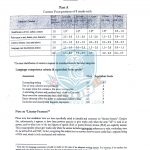Special Features of Earnest Hemingway’s Writing Style
Hemingway

Earnest Hemingway is an American modernist writer, and is wildly known for the introduction of the theory of omission, also known as Iceberg Theory as a style of writing. It should be noted that it is often difficult to separate the common man from the writings of Hemingway, as his style of writing is strictly associated with the struggles of the modern man, as results of the first world war, Spanish civil war, and the second world war. Depression, disillusionment, disaffection, and the social changes erupted along with the liberated concepts are strict subject matters associated in his writings.
Real People

One of the most iconic features of Hemingway’s writing style is the usage of real people as his subject matters, which makes the margin between fiction and reality indecisive. The amalgamation of such characters makes them rather dimensional so that it makes the story more believable.
Iceberg theory

The employment of the iceberg theory is another significant characteristic of Hemingway’s writing style. It focuses on minimalism and does not strictly focus on explicit underlying themes and characteristics. 7/8ths of the intended meaning shines through implicitly in most cases of his writings. One of the best examples can be seen in the short story, “Hills Like White Elephants” in which the readers find a couple waiting at a train station connotes their discussion of abortion. Yet, remarkably, the storyteller avoids the usage of the word ‘abortion’ and suggests the underlying reality through clear yet, highly metaphorical language.
Symbolical language

When it comes to Hemingway’s style, it’s hard not to talk about his highly symbolical language. In many cases, almost all nouns in his stories carry a secondary meaning. The many symbols used obviously contribute to create the iceberg effect in the story as well.
Repetitions

Even though Hemingway attempts to reduce the word count, and to make the story as much simple as possible for the reader to interpret, there are significant repetitions which occasionally add emphasis to specific character traits such as their unquenchable desires, likes, and dislikes.
“The wife liked him. She liked the deadly serious way he received any complaints. She liked his dignity. She liked the way he wanted to serve her. She liked the way he felt about being a hotel-keeper. She liked his old, heavy face and big hands.”
Other languages

Hemingway’s fluency in other languages can be seen as yet another significant feature in his writing style. Spanish, French, and Italian languages are craftily used in certain scenarios of the stories in a way that even those who are not aware of the foreign languages can understand the situational suggestions implied, without getting distracted.
Lack of adjectives and adverbs

Furthermore, the lack of adjectives and adverbs can be recognized as another key feature of Hemingway’s style. He seldom modifies imprecise words which automatically makes the style of writing less abstract. In general, the reader will occasionally find an expression such as “he smiled sadly”, which substantively changes the meaning of the smile, rather than “he smiled happily” in which the adverb is redundant.
Short sentences

On the one hand, Earnest Hemingway often refrains the usage of long complex sentences and replaces them with short and simple sentences in order to make the reader fully engaged in the story. The writer is very well aware of the possibility of the reader to skim the text without fully reading once the level of complexity is too high.
Polysyndeton

On the other hand, polysyndeton can be seen as another – notable strategy employed by Hemingway. Even though he avoids convoluted sentences, many simple declarative sentences are combined to create a panoramic sweep as well as to augment the suspense of the reader – without sacrificing the clarity of the meaning. The technique, in many cases, emphasizes the internal thoughts, expectations of characters along with the cravings, grievances, fears, and expectations. One of the best examples of the techniques can be seen in the short story, “cat in the rain” where the American wife lets out her emotional frustration;
“And I want to eat at a table with my own silver and I want candles. And I want it to be spring and I want to brush my hair out in front of a mirror and I want a kitty and I want some new clothes.”
Absence of commas

To add to that, Hemingway adopts a new style into his compound sentences by cutting off the commas in a way which does not affect the reader’s understanding of the story. Often the reader ends up reading longer sentences which lack breathing pauses. The briskly and the breathless feeling often add a sense of urgency to the expressions, as in the lines from the short story, “Cat in the Rain”;
“I want to pull my hair back tight and smooth and make a big knot at the back that I can feel,’ she said. ‘I want to have a kitty to sit on my lap and purr when I stroke her.”
Limitation of subordination

When it comes to the grammatical sense of syntax, Hemingway seems to have used a peculiar style. With the usage of polysyndeton, he cuts off subordination of in clauses. In grammar, coordination is the combination of two equally important sentences, and subordination involves two or more clauses with unequal weights. Hemingway usually avoids constructing sentences such as; “I want to have a kitty on my lap because I want it to purr when I stroke her” in which “I want to have a kitty on my lap” is the main clause which stands independently and carries more weight. “because I want it to purr when I stroke her” is the subordinating clause which depends on the main clause, and it has less weight in the overall sentence. Yet, he uses “I want to have a kitty to sit on my lap and purr when I stroke her.” In which “I want to have a kitty to sit on my lap”, and “and purr when I stroke her”. Are both simple sentences which carry equal weight.
White spacing

Not only the sentence structure but also the overall structure of paragraphing is unique too in the style of Hemingway. White spacing is a unique, but established writing practice, and Hemingway seems to be a master of the strategy. He effectively removes the apparent weight of paragraphs my making them short in length, which helps to delineate the exact meaning of the story without excessive elaborations.
Stichomythia

Stichomythia is the inclusion of dialogues in alternate lines, which is a strategy common for prose, and drama. (The poetry variation of the device is amoebean ) It is an effective way of indicating subtle contention which augments emotional intensity. The narrative style further supports to increase the white spacing between paragraphs so that the content of the story becomes reader-friendly.
“‘I’m going down and get that kitty,’ the American wife said.
‘I’ll do it,’ her husband offered from the bed.
‘No, I’ll get it. The poor kitty out trying to keep dry under a table.’”
“‘A cat?’
‘Si, il gatto.’
‘A cat?’ the maid laughed. ‘A cat in the rain?’
‘Yes,”




